Contribution of Interface Fracture Mechanism on Fracture Propagation Trajectory of Heterogeneous Asphalt Composites
Abstract
1. Introduction
2. Test Specimens
3. Mix Design
4. Results and Discussion
4.1. Fracture Resistance Values of Tested Samples
4.2. Fracture Trajectory Results
4.2.1. Mode I Fracture
4.2.2. Mixed Mode Fracture Trajectory
5. Conclusions
- The fracture resistance, fracture trajectory and fracture surface of the asphalt samples were investigated under different mode mixities and testing conditions using different test samples and configurations.
- The fracture resistance values (i.e., critical stress intensity factors, KIf, KIIf and KIIIf) were dependent to the shape of test sample, applied loading type, loading mode, and temperature. Generally, the fracture resistance was decreased by increasing the test temperature and changing the loading mode from tensile type to shear type.
- The heterogeneity of the asphalt mixture and location of the coarse aggregates in the route of fracture propagation along the ligament can noticeably affect the trajectory of fracture. The fracture path shows more deviations relative to the path observed for a model brittle and isotropic material, when the coarser aggregates are located in front of the trajectory of propagating crack. Indeed, the crack tends to round the aggregates in most of the cases and propagate through the softer mastic part or the interface of aggregate/mastic.
- Increasing the temperature can result in more deviation in the fracture trajectory because of the reduction in the stiffness of mastic and bitumen relative to the aggregate and tendency of the crack to not grow through the aggregates by rounding them.
- Observation of fracture surface for all mode mixities revealed that a significant part of the fracture surface (i.e., greater than 80% of the fracture surface) propagates through the mastic and interface of aggregates/mastic. This percentage increases with increasing the test temperature or adding the contribution of mode II or mode III in the process of asphalt cracking.
Author Contributions
Funding
Institutional Review Board Statement
Informed Consent Statement
Data Availability Statement
Conflicts of Interest
References
- Wagoner, M.P.; Buttlar, W.G.; Paulino, G.H.; Blankenship, P. Investigation of the fracture resistance of hot-mix asphalt concrete using a disk-shaped compact tension test. Transp. Res. Rec. J. Transp. Res. Board 2005, 1929, 183–192. [Google Scholar] [CrossRef]
- Li, X.; Braham, A.F.; Marasteanu, M.O.; Buttlar, W.G.; Williams, R.C. Effect of Factors Affecting Fracture Energy of Asphalt Concrete at Low Temperature. Road Mater. Pavement Des. 2008, 9, 397–416. [Google Scholar] [CrossRef]
- Wagnoner, M.P.; Buttlar, W.G.; Paulino, G.H. Disk-shaped compact tension test for asphalt concrete fracture. Exp. Mech. 2005, 45, 270–277. [Google Scholar] [CrossRef]
- Wang, H.; Zhang, C.; Li, L.; You, Z.; Diab, A. Characterization of Low Temperature Crack Resistance of Crumb Rubber Modified Asphalt Mixtures Using Semi-Circular Bending Tests. J. Test. Eval. 2016, 44, 847–855. [Google Scholar] [CrossRef]
- Aliha, M.; Behbahani, H.; Fazaeli, H.; Rezaifar, M. Study of characteristic specification on mixed mode fracture toughness of asphalt mixtures. Constr. Build. Mater. 2014, 54, 623–635. [Google Scholar] [CrossRef]
- Aliha, M.; Fazaeli, H.; Aghajani, S.; Nejad, F.M. Effect of temperature and air void on mixed mode fracture toughness of modified asphalt mixtures. Constr. Build. Mater. 2015, 95, 545–555. [Google Scholar] [CrossRef]
- Mirsayar, M.M.; Shi, X.; Zollinger, D.G. Evaluation of interfacial bond strength between Portland cement concrete and asphalt concrete layers using bi-material SCB test specimen. Eng. Solid Mech. 2017, 293–306. [Google Scholar] [CrossRef]
- Marasteanu, M.O.; Dai, S.; Labuz, J.F.; Li, X. Determining the Low-Temperature Fracture Toughness of Asphalt Mixtures. Transp. Res. Rec. J. Transp. Res. Board 2002, 1789, 191–199. [Google Scholar] [CrossRef]
- Kim, H.; Wagoner, M.P.; Buttlar, W.G. Micromechanical fracture modeling of asphalt concrete using a single-edge notched beam test. Mater. Struct. 2008, 42, 677–689. [Google Scholar] [CrossRef]
- Majidzadeh, K. Application of Fracture Mechanics for Improve Design of Bituminous Concrete; Rep, FHWA-RD-76-91, 1 & 2; Federal Highway Administration: Washington, DC, USA, 1976. [Google Scholar]
- Molenaar, A.A.A. Fatigue and reflection cracking due to traffic loads. J. Assoc. Asphalt Technol. 1984, 53, 440–474. [Google Scholar]
- Molenaar, A.A.; Scarpas, A.A.; Liu, X.; Erkens, G. Semi-circular bending test; simple but useful. J. Assoc. Asphalt Technol. 2002, 71, 794–815. [Google Scholar]
- Roque, R.; Zhang, Z.; Sankar, B. Determination of crack growth rate parameters of asphalt mixtures using the Superpave IDT. J. Assoc. Asphalt Technol. 1999, 68, 404–433. [Google Scholar]
- Stewart, C.M.; Oputa, C.W.; Garcia, E. Effect of specimen thickness on the fracture resistance of hot mix asphalt in the disk-shaped compact tension (DCT) configuration. Constr. Build. Mater. 2018, 160, 487–496. [Google Scholar] [CrossRef]
- Link, R.P.; Wagoner, M.; Buttlar, W.; Paulino, G. Development of a Single-Edge Notched Beam Test for Asphalt Concrete Mixtures. J. Test. Eval. 2005, 33, 33. [Google Scholar] [CrossRef]
- Jamaaoui, A.; Pop, O.; Ktari, R.; Millien, A.; Petit, C. Analyzing of Wedge Splitting Test on Asphalt Pavement Using Optical Measurements. J. Test. Eval. 2017, 45, 1959–1970. [Google Scholar] [CrossRef]
- Motamedi, H.; Fazaeli, H.; Aliha, M.; Amiri, H.R. Evaluation of temperature and loading rate effect on fracture toughness of fiber reinforced asphalt mixture using edge notched disc bend (ENDB) specimen. Constr. Build. Mater. 2020, 234, 117365. [Google Scholar] [CrossRef]
- Pour, P.H.; Aliha, M.R.; Keymanesh, M.R. Evaluating mode i fracture resistance in asphalt mixtures using edge notched disc bend endb specimen with different geometrical and environmental conditions. Eng. Fract. Mech. 2018, 190, 245–258. [Google Scholar] [CrossRef]
- Aliha, M.; Razmi, A.; Mousavi, A. Fracture study of CONCRETE composites with synthetic fibers ADDITIVE under modes I and III Using endb specimen. Constr. Build. Mater. 2018, 190, 612–622. [Google Scholar] [CrossRef]
- Aliha, M.; Bahmani, A.; Akhondi, S. A novel TEST specimen for investigating the mixed MODE I+III fracture toughness of hot MIX asphalt composites–Experimental and theoretical study. Int. J. Solids Struct. 2016, 90, 167–177. [Google Scholar] [CrossRef]
- Mansourian, A.; Hashemi, S.; Aliha, M.R. Evaluation of pure and mixed MODES (I/III) fracture toughness of Portland cement concrete mixtures containing RECLAIMED asphalt pavement. Constr. Build. Mater. 2018, 178, 10–18. [Google Scholar] [CrossRef]
- Eghbali, M.; Fallah Tafti, M.; Aliha, M.; Motamedi, H. The effect of endb SPECIMEN geometry on mode i fracture toughness and Fracture energy of HMA and SMA mixtures at low temperatures. Eng. Fract. Mech. 2019, 216, 106496. [Google Scholar] [CrossRef]
- Aliha, M.; Pour, P.J.H. Fracture resistance study for hot mix asphalt mixture under out of plane sliding mode. Eng. Fract. Mech. 2020, 238, 107230. [Google Scholar] [CrossRef]
- Shahryari, N.; Keymanesh, M.; Aliha, M. Specimen type effect on measured low-temperature fracture toughness of asphalt concrete. Fatigue Fract. Eng. Mater. Struct. 2021, 44, 551–567. [Google Scholar] [CrossRef]
- Aliha, M.; Sarbijan, M.; Bahmani, A. Fracture toughness determination of modified HMA mixtures with two novel disc shape configurations. Constr. Build. Mater. 2017, 155, 789–799. [Google Scholar] [CrossRef]
- Bahmani, A.; Farahmand, F.; Ataei, F.; Aliha, M.R.M. Mixed mode I/III fracture parameters for edge-notched diametrically compressed disc specimen. Mater. Des. Process. Commun. 2019, 1. [Google Scholar] [CrossRef]
- Bahmani, A.; Farahmand, F.; Janbaz, M.; Darbandi, A.; Ghesmati-Kucheki, H.; Aliha, M. On the comparison of two mixed-mode I + III fracture test specimens. Eng. Fract. Mech. 2021, 241, 107434. [Google Scholar] [CrossRef]
- Mubaraki, M.; Abd-Elhady, A.A.; Sallam, H.E.M. Mixed mode fracture toughness of recycled tire rubber-filled concrete for airfield rigid pavements. Int. J. Pavement Res. Technol. 2013, 6, 8–14. [Google Scholar]
- Ameri, M.; Nowbakht, S.; Molayem, M.; Aliha, M.R.M. Investigation of fatigue and fracture properties of asphalt mixtures modified with carbon nanotubes. Fatigue Fract. Eng. Mater. Struct. 2016, 39, 896–906. [Google Scholar] [CrossRef]
- Ameri, M.; Mansourian, A.; Pirmohammad, S.; Aliha, M.; Ayatollahi, M. Mixed mode fracture resistance of asphalt concrete mixtures. Eng. Fract. Mech. 2012, 93, 153–167. [Google Scholar] [CrossRef]
- Pérez-Jiménez, F.; Botella, R.; Moon, K.-H.; Marasteanu, M. Effect of load application rate and temperature on the fracture energy of asphalt mixtures. Fénix and semi-circular bending tests. Constr. Build. Mater. 2013, 48, 1067–1071. [Google Scholar] [CrossRef]
- Li, X.-J.; Marasteanu, M.O. Using Semi Circular Bending Test to Evaluate Low Temperature Fracture Resistance for Asphalt Concrete. Exp. Mech. 2010, 50, 867–876. [Google Scholar] [CrossRef]
- Aliha, M.R.M.; Amirdehi, H.R.F. Fracture toughness prediction using Weibull statistical method for asphalt mixtures containing different air void contents. Fatigue Fract. Eng. Mater. Struct. 2017, 40, 55–68. [Google Scholar] [CrossRef]
- Aliha, M.R.M.; Behbahani, H.; Fazaeli, H.; Rezaifar, M.H. Experimental study on mode I fracture toughness of different asphalt mixtures. Sci. Iran. Trans. A Civ. Eng. 2015, 22, 120. [Google Scholar]
- Zeinali, A.; Mahboub, K.C.; Blankenship, P.B. Development of the indirect ring tension fracture test for hot-mix asphalt. Road Mater. Pavement Des. 2014, 15, 146–171. [Google Scholar] [CrossRef]
- Kim, H.; Buttlar, W.G. Discrete fracture modeling of asphalt concrete. Int. J. Solids Struct. 2009, 46, 2593–2604. [Google Scholar] [CrossRef]
- Zhao, Y.; Jiang, L.; Zhou, L.; Jiang, J. Heterogeneous Fracture Simulation of Asphalt Mixture under Beam Bending Test with Cohesive Zone Modeling. Transp. Res. Congr. 2017 2019. [Google Scholar] [CrossRef]
- Dai, Q.; Sadd, M.H.; Parameswaran, V.; Shukla, A. Prediction of Damage Behaviors in Asphalt Materials Using a Micromechanical Finite-Element Model and Image Analysis. J. Eng. Mech. 2005, 131, 668–677. [Google Scholar] [CrossRef]
- Ng, K.; Dai, Q. Investigation of Fracture Behavior of Heterogeneous Infrastructure Materials with Extended-Finite-Element Method and Image Analysis. J. Mater. Civ. Eng. 2011, 23, 1662–1671. [Google Scholar] [CrossRef]
- Aliha, M.; Ziari, H.; Mojaradi, B.; Sarbijan, M.J. Heterogeneity effects on mixed-mode I/II stress intensity factors and fracture path of laboratory asphalt mixtures in the shape of SCB specimen. Fatigue Fract. Eng. Mater. Struct. 2019, 43, 586–604. [Google Scholar] [CrossRef]
- Aliha, M.; Sarbijan, M. Effects of loading, geometry and material properties on fracture parameters of a pavement containing top-down and bottom-up cracks. Eng. Fract. Mech. 2016, 166, 182–197. [Google Scholar] [CrossRef]
- Ziari, H.; Aliha, M.R.M.; Mojaradi, B.; Sarbijan, M.J. Investigating the effects of loading, mechanical properties and layers geometry on fatigue life of asphalt pavements. Fatigue Fract. Eng. Mater. Struct. 2019, 42, 1563–1577. [Google Scholar] [CrossRef]
- Aliha, M.; Ziari, H.; Fard, E.S.; Sarbijan, M.J. Heterogeneity effect on fracture parameters of a multilayer asphalt pavement structure containing a top-down crack and subjected to moving traffic loading. Fatigue Fract. Eng. Mater. Struct. 2021. [Google Scholar] [CrossRef]
- Li, W.; Guo, L. Meso-fracture simulation of cracking process in concrete incorporating three-phase characteristics by peridynamic method. Constr. Build. Mater. 2018, 161, 665–675. [Google Scholar] [CrossRef]
- Yin, A.; Yang, X.; Gao, H.; Zhu, H. Tensile fracture simulation of random heterogeneous asphalt mixture with cohesive crack model. Eng. Fract. Mech. 2012, 92, 40–55. [Google Scholar] [CrossRef]
- Ayatollahi, M.; Aliha, M. Wide range data for crack tip parameters in two disc-type specimens under mixed mode loading. Comput. Mater. Sci. 2007, 38, 660–670. [Google Scholar] [CrossRef]
- Fayed, A.S. Numerical evaluation of mode I/II SIF of quasi-brittle materials using cracked semi-circular bend specimen. Eng. Solid Mech. 2018, 6, 175–186. [Google Scholar] [CrossRef]
- Fuan, S.; Ke, M.; Kanghe, L.; Kun, L.; Aliha, M. Influence of specimen geometry on mode I fracture toughness of asphalt concrete. Constr. Build. Mater. 2021, 276, 122181. [Google Scholar] [CrossRef]


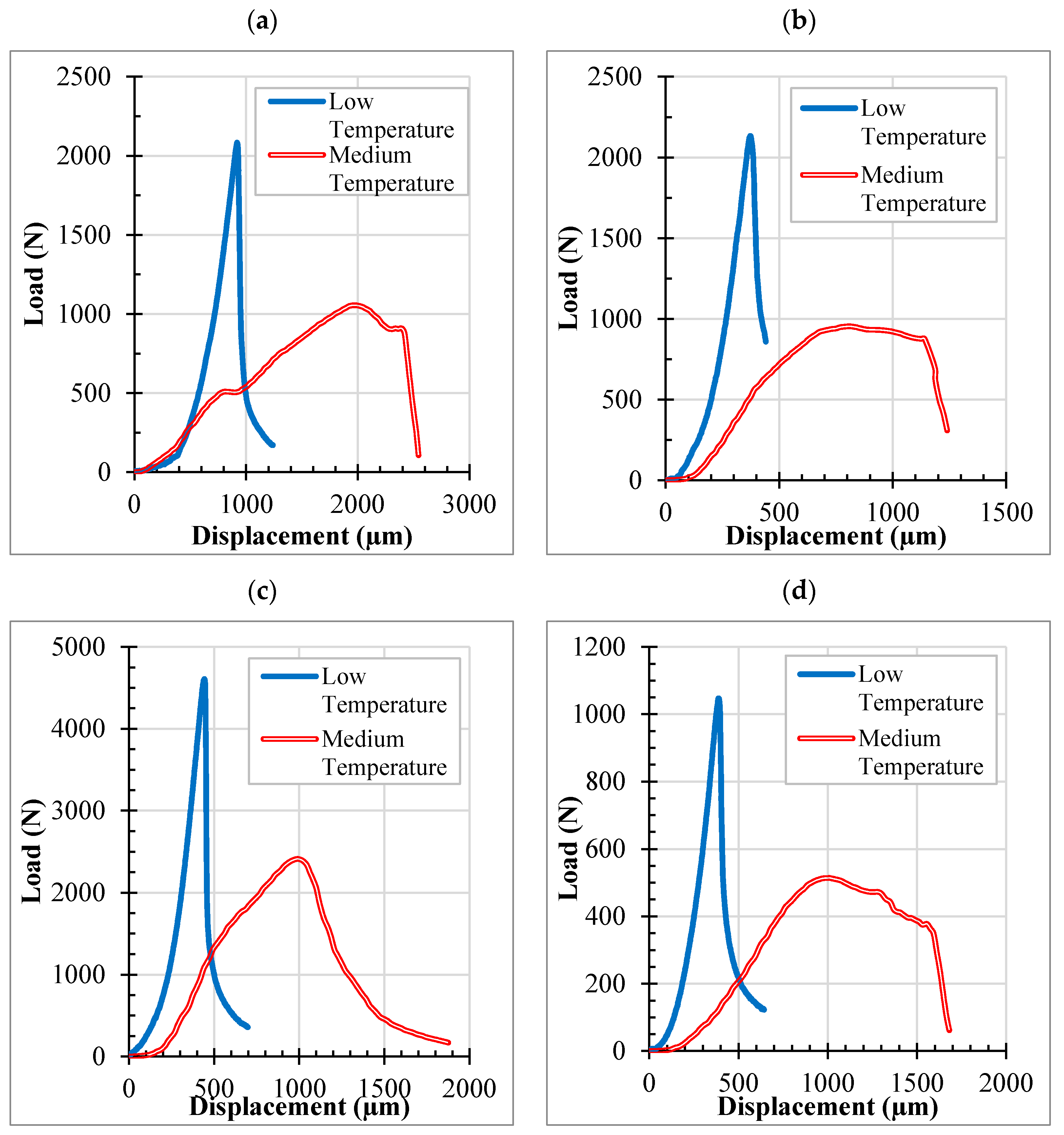
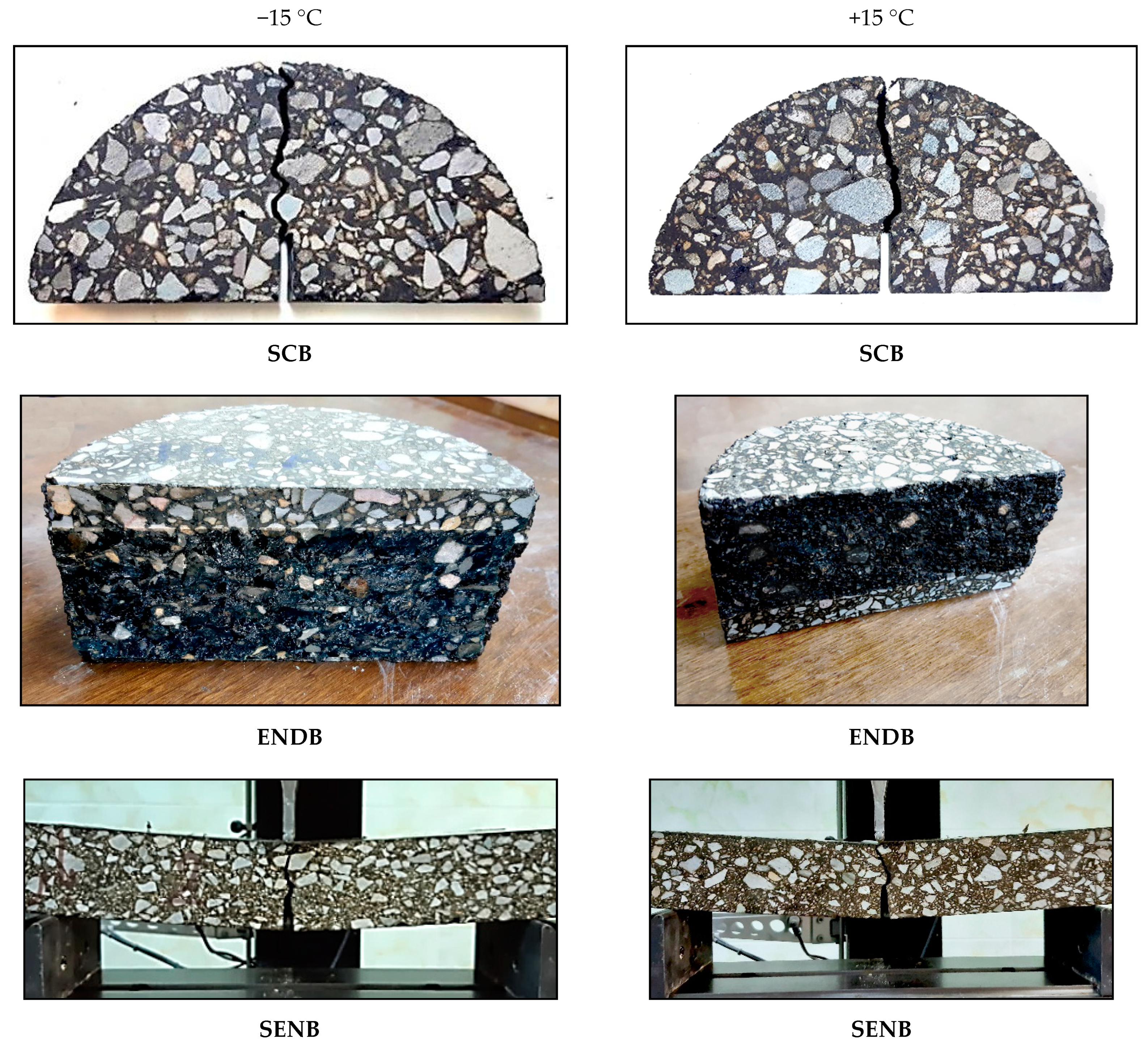
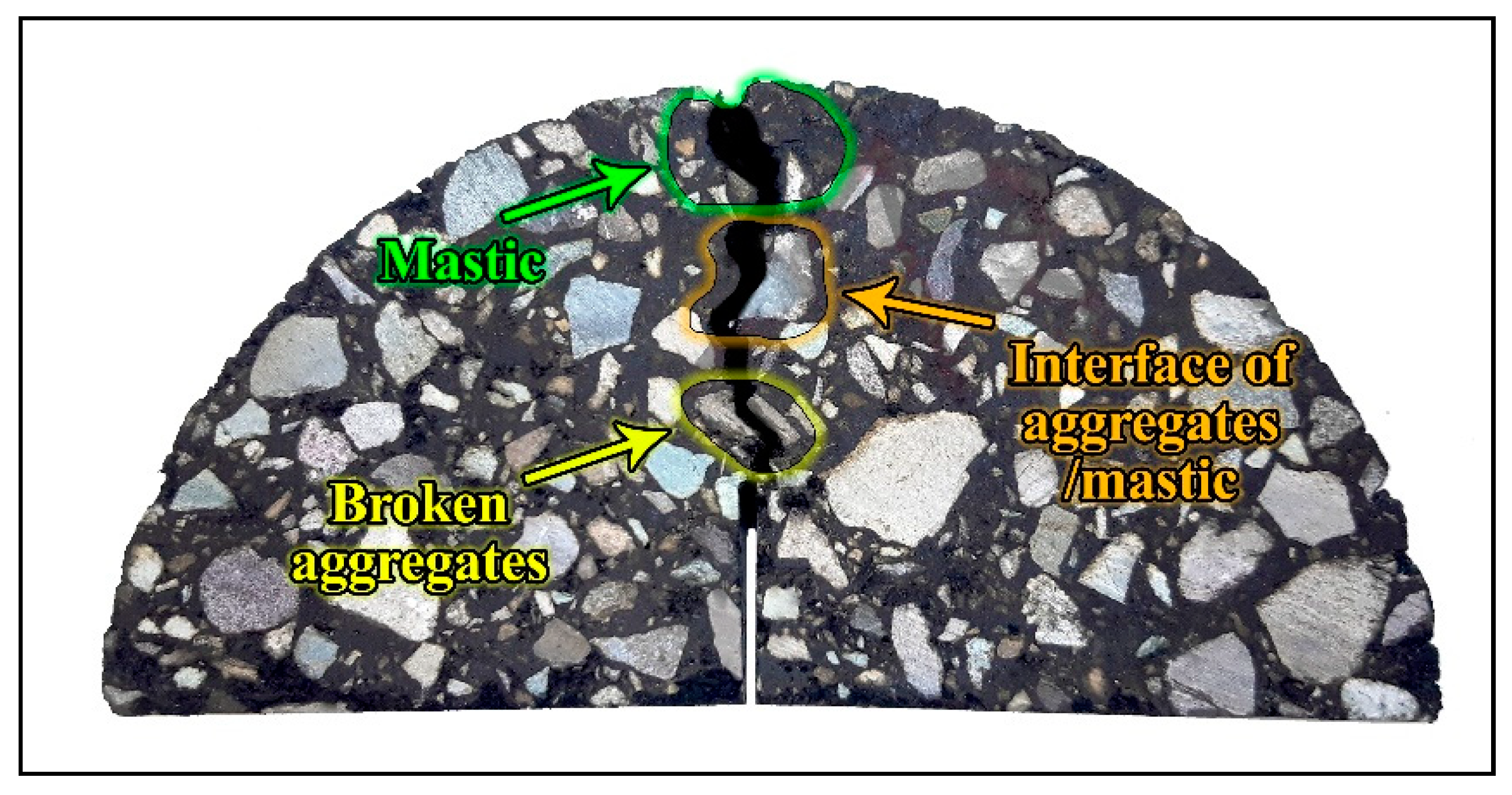
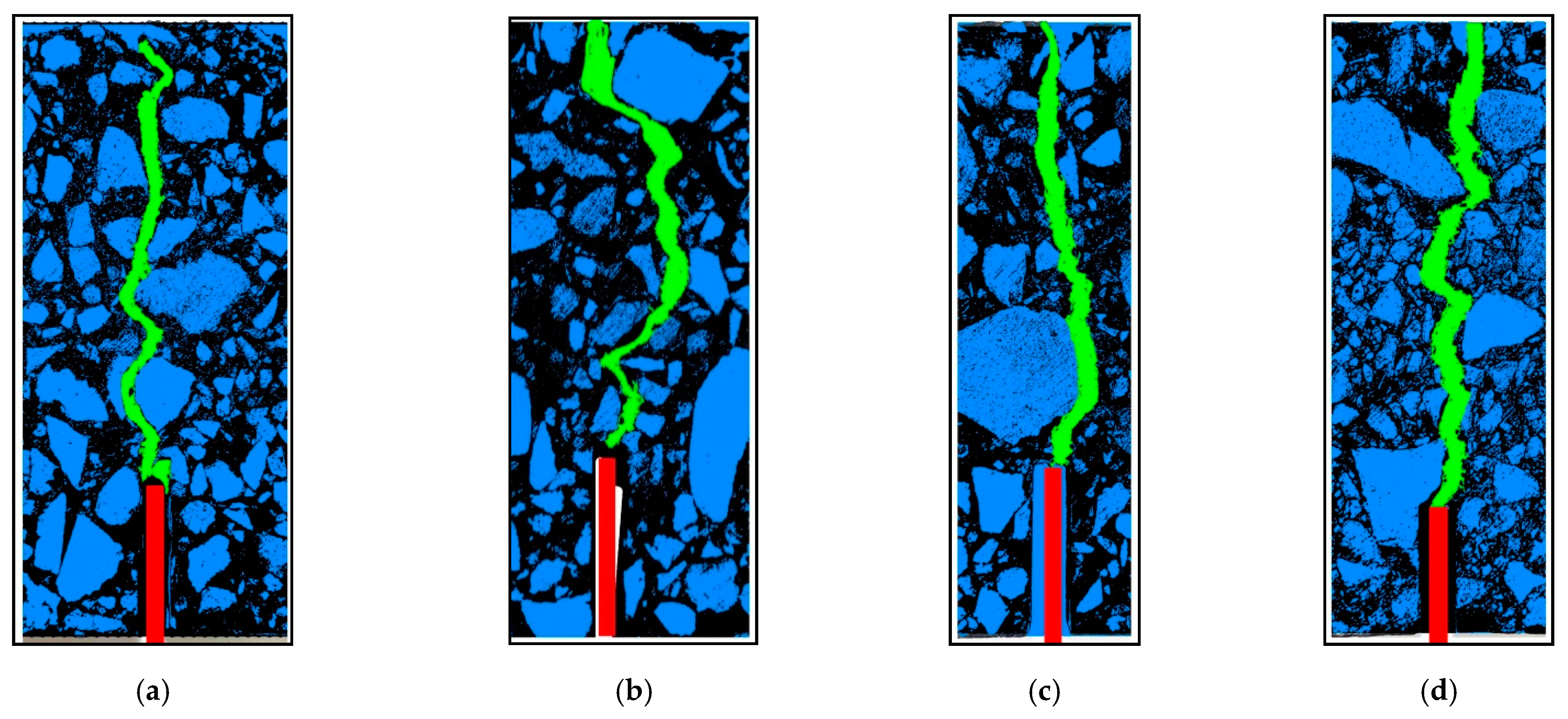
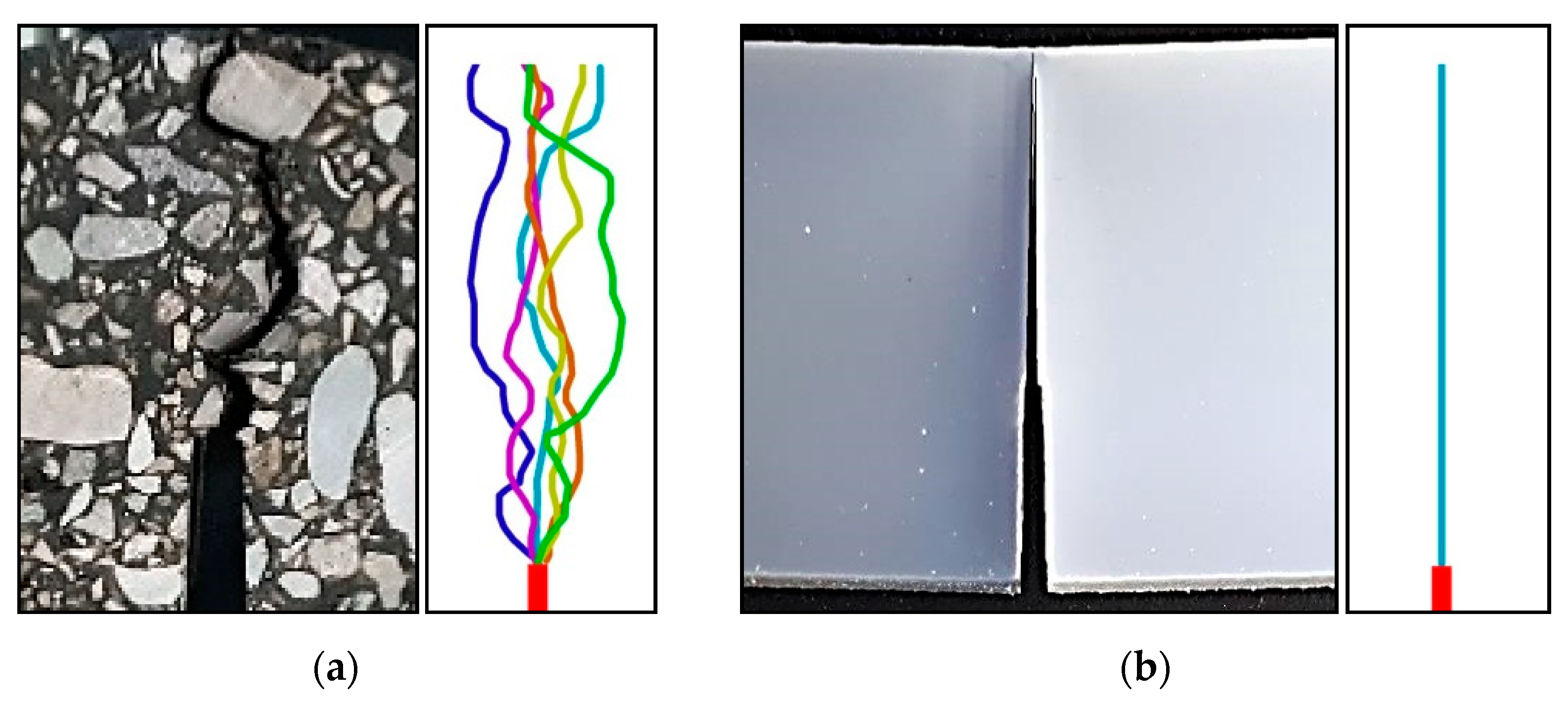


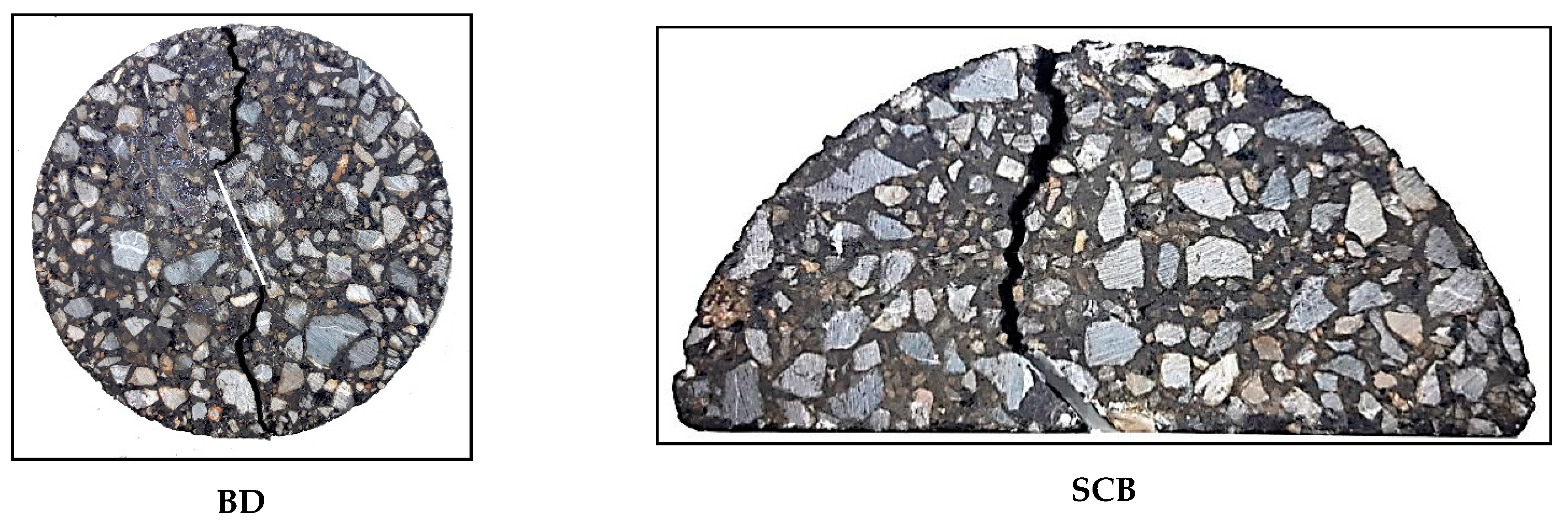
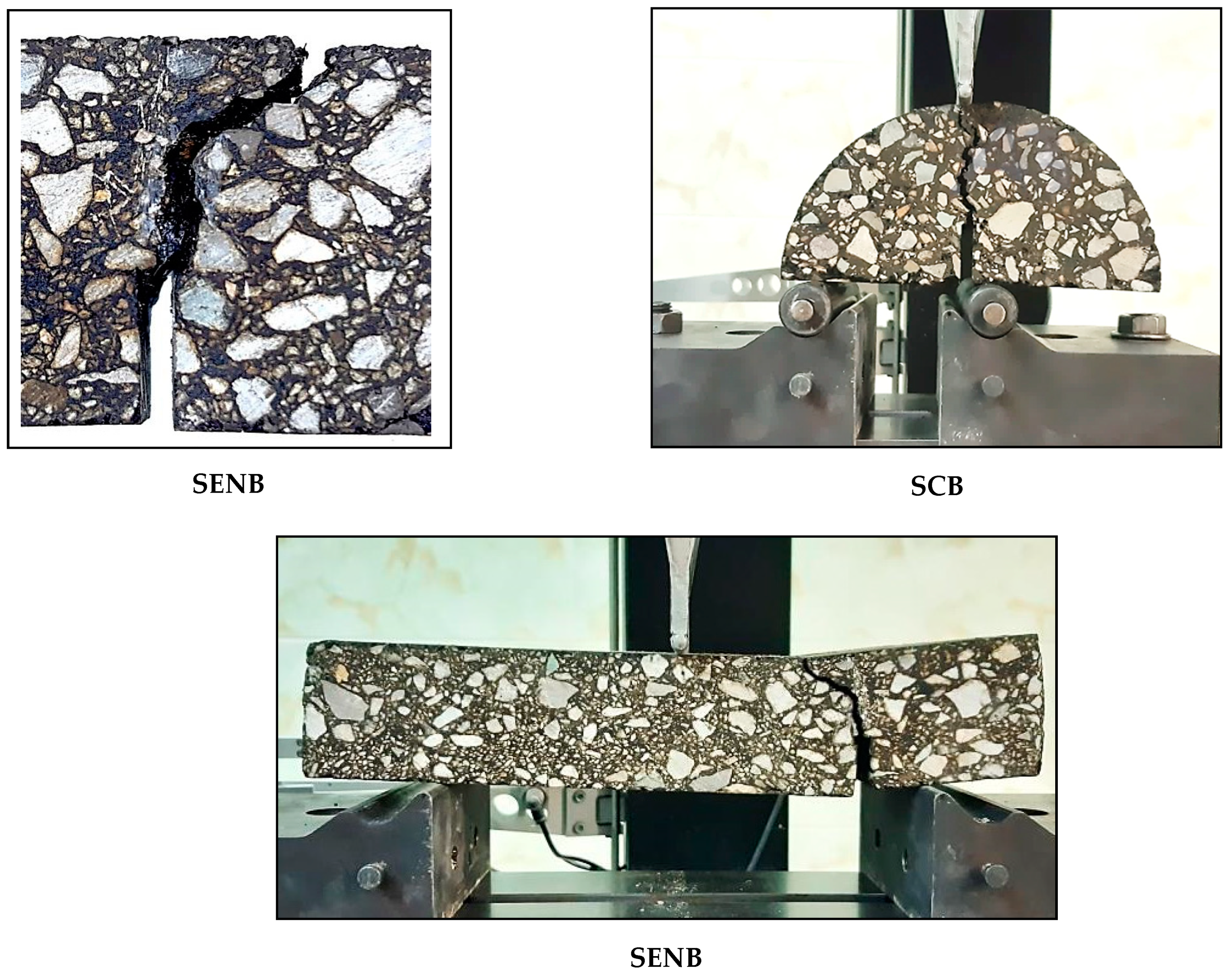

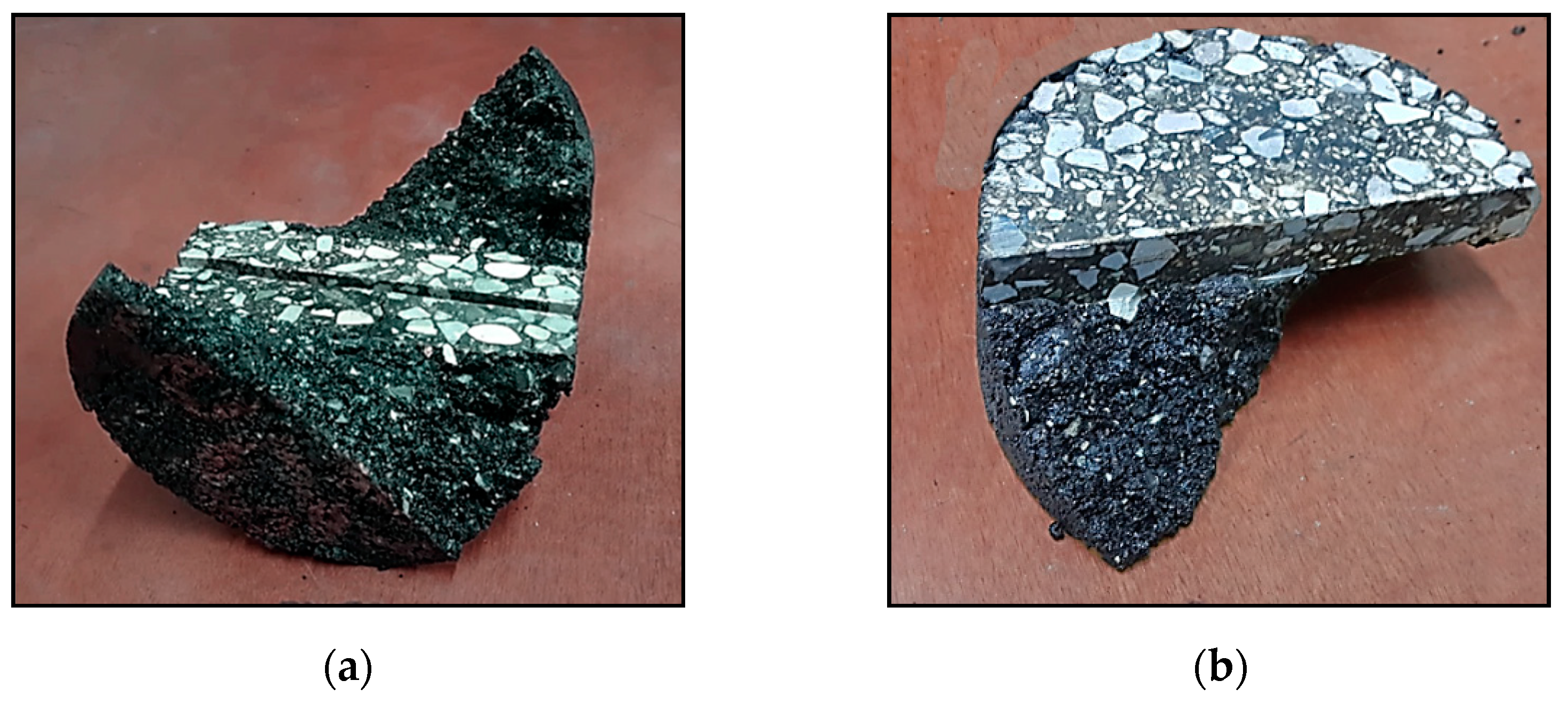
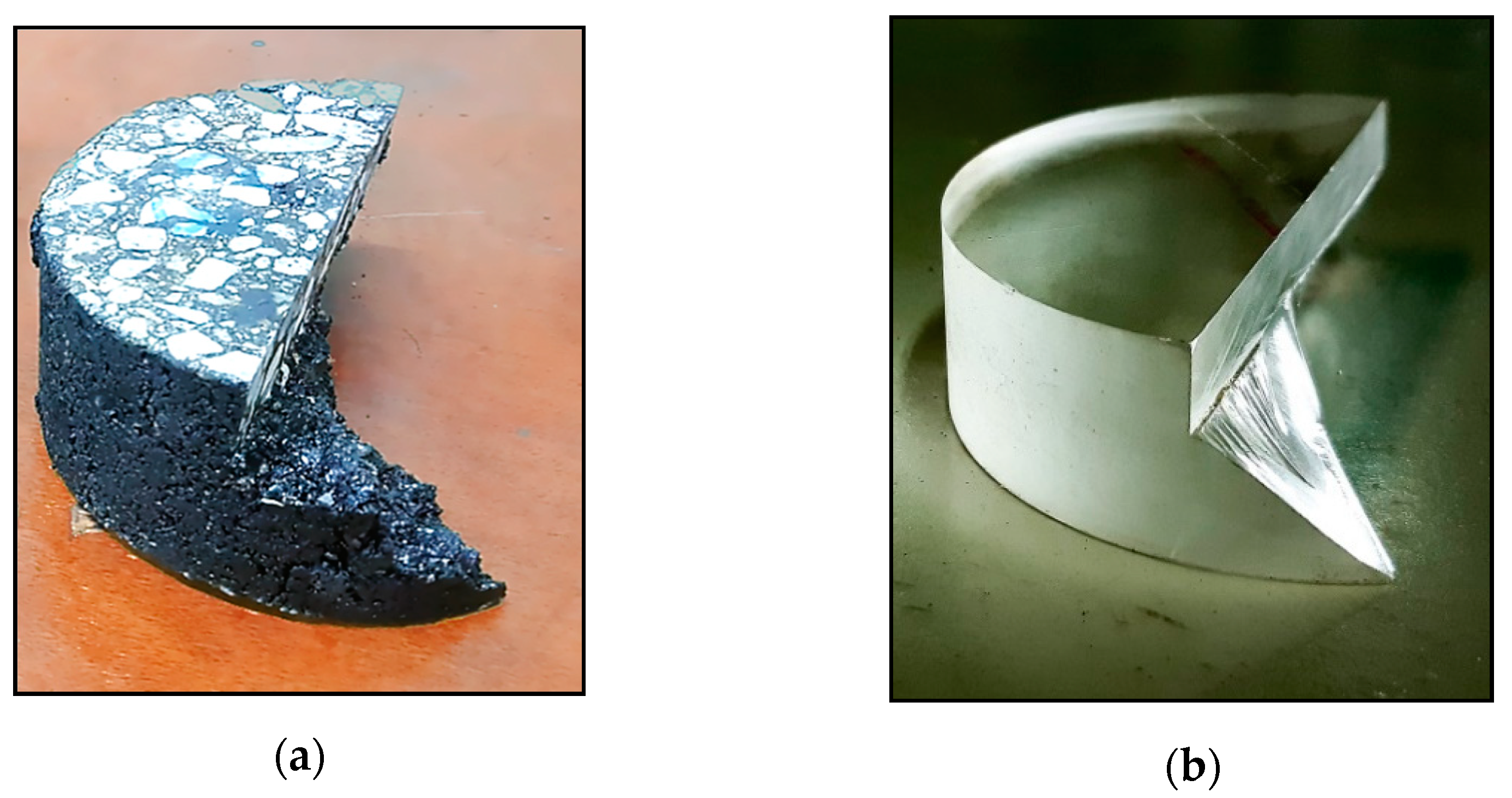
| Specimen | Pure Mode I | Mixed Mode I/II | Pure Mode II | Pure Mode III | Mixed Mode I/III | ||
|---|---|---|---|---|---|---|---|
| SCB | Asymmetric SCB | Test condition | S1/R = 0.8 S2/R = 0.8 | S1/R = 0.8 S2/R = 0.18 | S1/R = 0.8 S2/R = 0.083 | - | - |
| Geometry factor | YI = 4.0 | YI = 14.5 YII = 14.5 | YII = 21.37 | - | - | ||
| Inclined cracked SCB | Test condition | - | S/R = 0.65 β = 37° | S/R = 0.65 β = 55° | - | - | |
| Geometry factor | - | YI = 1.2 YII = 1.2 | YII = 1.28 | - | - | ||
| ENDB | Test condition | S1/R = 0.9 S2/R = 0.9 | - | - | S/R = 0.95 β = 65° | S/R = 0.95 β = 53° | |
| Geometry factor | YI = 1.25 | - | - | YIII = 0.071 | YI = 0.065 YIII = 0.077 | ||
| BD | Test condition | β = 0° | β = 15° | β = 28° | - | - | |
| Geometry factor | YI = 1.1 | YI = 1.1 YII = 0.8 | YII = 1.8 | - | - | ||
| SENB | Test condition | S1/L = 0.7 S2/L = 0.7 | S/L = 0.7 d/S = 0.55 | - | - | - | |
| Geometry factor | YI = 4.1 | YI = 3.2 YII = 0.5 | - | - | - | ||
| Test | Value | Test Method |
|---|---|---|
| Specific gravity | 2.42 g/cm3 | ASTM C-127 |
| L.A. Abrasion | 23 (%) | AASHTO T-96 |
| Absorption (coarse aggregate) | 1.5 (%) | AASHTO T-85 |
| Absorption (fine aggregate) | 1 (%) | AASHTO T-84 |
| Percent fracture (one face) | 98 (%) | ASTM D5821 |
| Percent fracture (two face) | 91 (%) | ASTM D5821 |
| Sieve Size | Passing Percent |
|---|---|
| 19 | 100 |
| 12.5 | 95 |
| 9 | 80 |
| 4.75 | 59 |
| 2.36 | 43 |
| 1.18 | 30 |
| 0.5 | 18 |
| 0.3 | 13 |
| 0.15 | 8 |
| 0.075 | 6 |
| Optimal Bitumen (%) | Marshall Resistance (kN) | VMA * (%) | VFA ** (%) |
|---|---|---|---|
| 5.8 | 12.2 | 14.6 | 67.8 |
| Specimen | Temperature | Pure Mode I | Mixed Mode I/II | Pure Mode II | Pure Mode III | Mixed Mode I/III | |||
|---|---|---|---|---|---|---|---|---|---|
| KIf | KIf | KIIf | KIIf | KIIIf | KIf | KIIIf | |||
| SCB | Asymmetric SCB | Low | 0.82 | 0.54 | 0.54 | 0.78 | - | - | - |
| Medium | 0.38 | 0.21 | 0.21 | 0.34 | - | - | - | ||
| Inclined cracked SCB | Low | - | 0.51 | 0.57 | 0.68 | - | - | - | |
| Medium | - | 0.20 | 0.23 | 0.29 | - | - | - | ||
| ENDB | Low | 0.78 | - | - | - | 0.45 | 0.41 | 0.48 | |
| Medium | 0.40 | - | - | - | 0.21 | 0.22 | 0.25 | ||
| BD | Low | 0.66 | 0.45 | 0.41 | 0.82 | - | - | - | |
| Medium | 0.32 | 0.25 | 0.22 | 0.45 | - | - | - | ||
| SENB | Low | 0.75 | 0.62 | 0.07 | - | - | - | - | |
| Medium | 0.36 | 0.29 | 0.03 | - | - | - | - | ||
| Specimen | Fracture Path Location | Mode-I | Mode-II or Mixed Mode I/II | Mode-III or Mixed Mode I/III | |||
|---|---|---|---|---|---|---|---|
| Low Temp | Medium Temp | Low Temp | Medium Temp | Low Temp | Medium Temp | ||
| SCB | mastic | 60 | 80 | 75 | 90 | - | - |
| aggregates | 30 | 12 | 5 | 0 | - | - | |
| interface of aggregate/mastic | 10 | 8 | 20 | 10 | - | - | |
| ENDB | mastic | 70 | 85 | - | - | 90 | 95 |
| aggregates | 15 | 10 | - | - | 5 | 0 | |
| interface of aggregate/mastic | 15 | 5 | - | - | 5 | 5 | |
| BD | mastic | 70 | 90 | 85 | 90 | - | - |
| aggregates | 20 | 5 | 10 | 2 | - | - | |
| interface of aggregate/mastic | 10 | 5 | 5 | 8 | - | - | |
| SENB | mastic | 65 | 90 | 90 | 93 | - | - |
| aggregates | 15 | 2 | 5 | 2 | - | - | |
| interface of aggregate/mastic | 20 | 8 | 5 | 5 | - | - | |
Publisher’s Note: MDPI stays neutral with regard to jurisdictional claims in published maps and institutional affiliations. |
© 2021 by the authors. Licensee MDPI, Basel, Switzerland. This article is an open access article distributed under the terms and conditions of the Creative Commons Attribution (CC BY) license (http://creativecommons.org/licenses/by/4.0/).
Share and Cite
He, J.; Liu, L.; Yang, H.; Aliha, M.R.M.; Karimi, H.R. Contribution of Interface Fracture Mechanism on Fracture Propagation Trajectory of Heterogeneous Asphalt Composites. Appl. Sci. 2021, 11, 3013. https://doi.org/10.3390/app11073013
He J, Liu L, Yang H, Aliha MRM, Karimi HR. Contribution of Interface Fracture Mechanism on Fracture Propagation Trajectory of Heterogeneous Asphalt Composites. Applied Sciences. 2021; 11(7):3013. https://doi.org/10.3390/app11073013
Chicago/Turabian StyleHe, Jianxin, Liang Liu, Haihua Yang, M. R. M. Aliha, and Hamid Reza Karimi. 2021. "Contribution of Interface Fracture Mechanism on Fracture Propagation Trajectory of Heterogeneous Asphalt Composites" Applied Sciences 11, no. 7: 3013. https://doi.org/10.3390/app11073013
APA StyleHe, J., Liu, L., Yang, H., Aliha, M. R. M., & Karimi, H. R. (2021). Contribution of Interface Fracture Mechanism on Fracture Propagation Trajectory of Heterogeneous Asphalt Composites. Applied Sciences, 11(7), 3013. https://doi.org/10.3390/app11073013





